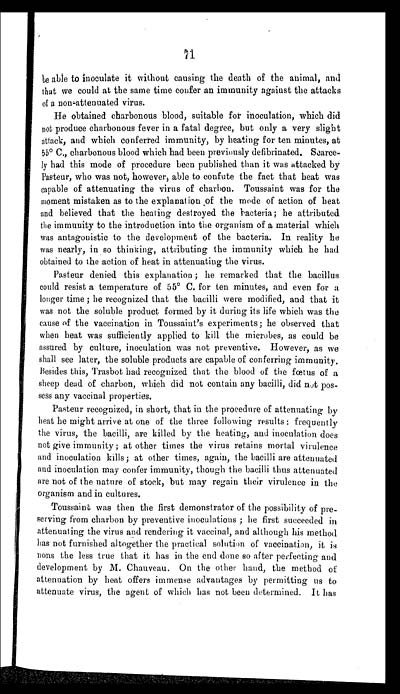Medicine - Veterinary > Civil Veterinary Departments > Civil Veterinary Department ledger series I-VI > Volume II - Anthrax
(237) Page 71
Download files
Individual page:
Thumbnail gallery: Grid view | List view

71
be able to inoculate it without causing the death of the animal, and
that we could at the same time confer an immunity against the attacks
of a non-attenuated virus.
He obtained charbonous blood, suitable for inoculation, which did
not produce charbouous fever in a fatal degree, but only a very slight
attack, and which conferred immunity, by heating for ten minutes, at
55° C., charbonous blood which had been previously defibrinated. Scarce-
ly had this mode of procedure been published than it was attacked by
Pasteur, who was not, however, able to confute the fact that heat was
capable of attenuating the virus of charbon. Toussaint was for the
moment mistaken as to the explanation of the mode of action of heat
and believed that the heating destroyed the bacteria; he attributed
the immunity to the introduction into the organism of a material which
was antagonistic to the development of the bacteria. In reality he
was nearly, in so thinking, attributing the immunity which he had
obtained to the action of heat in attenuating the virus.
Pasteur denied this explanation; he remarked that the bacillus
could resist a temperature of 55° C. for ten minutes, and even for a
longer time ; he recognized that the bacilli were modified, and that it
was not the soluble product formed by it during its life which was the
cause of the vaccination in Toussaint's experiments; he observed that
when heat was sufficiently applied to kill the microbes, as could be
assured by culture, inoculation was not preventive. However, as we
shall see later, the soluble products are capable of conferring immunity.
Besides this, Trasbot had recognized that the blood of the fœtus of a
sheep dead of charbon, which did not contain any bacilli, did not pos-
sess any vaccinal properties.
Pasteur recognized, in short, that in the procedure of attenuating by
heat he might arrive at one of the three following results: frequently
the virus, the bacilli, are killed by the heating, and inoculation does
not give immunity; at other times the virus retains mortal virulence
and inoculation kills; at other times, again, the bacilli are attenuated
and inoculation may confer immunity, though the bacilli thus attenuated
are not of the nature of stock, but may regain their virulence in the
organism and in cultures.
Toussaint was then the first demonstrator of the possibility of pre-
serving from charbon by preventive inoculations ; he first succeeded in
attenuating the virus and rendering it vaccinal, and although his method
has not furnished altogether the practical solution of vaccination, it is
nons the less true that it has in the end done so after perfecting and
development by M. Chauveau. On the other hand, the method of
attenuation by heat offers immense advantages by permitting us to
attenuate virus, the agent of which has not been determined. It has
Set display mode to: Large image | Zoom image | Transcription
Images and transcriptions on this page, including medium image downloads, may be used under the Creative Commons Attribution 4.0 International Licence unless otherwise stated. ![]()
| India Papers > Medicine - Veterinary > Civil Veterinary Departments > Civil Veterinary Department ledger series I-VI > Anthrax > (237) Page 71 |
|---|
| Permanent URL | https://digital.nls.uk/75516486 |
|---|




